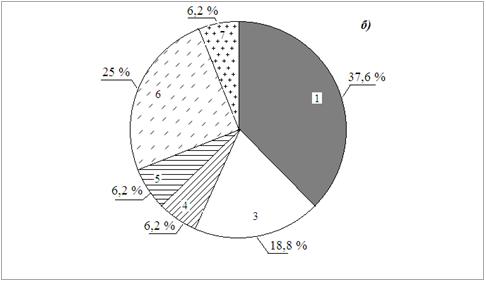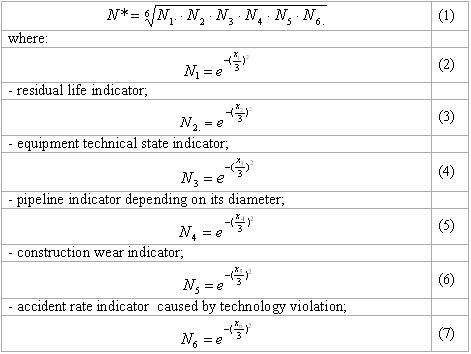ACCIDENT AND DAMAGE PREDICTION SYSTEM IN GAS TRUNK PIPELINES
ACCIDENT AND DAMAGE PREDICTION SYSTEM IN GAS TRUNK PIPELINES
Scientific article
Chuhareva N.V.¹, TikhonovaT.V.²
1, 2 National Research Tomsk Polytechnic University, Tomsk, Russia
Abstract
In accordance with the data collected through the ten-year period of gas trunk pipeline operation in JSC “Sakhatransneftegaz”, accident factors, as well as factors with maximal frequency in accident contribution have been defined. Based on the obtained results, the most dangerous zone in “Srednevilujskoye gas condensate field – Mastakh – Berge – Yakutsk” has been detected. It was assessed in terms of industrial safety indicators.
Key words: trunk gas pipeline, accidents and damages, predication system, accident causes.
Today, complex and system approach toward trunk pipeline technical condition monitoring includes not only its technical assessment, i.e. definition of its residual life and equipment wearing, but also the study of accident dynamics, as well as the identification of basic causes of pipeline accidents and damages. Such approach is considered to be the basis for predication and risk assessment system development within gas trunk pipeline facilities.
The object of the present research is the most accident zone of the gas trunk pipeline in the Republic of Sakha Yakutia.
The main peculiarity of the above-mentioned gas trunk pipeline is severe operating conditions. The continental climate is characterized by long winters with annual temperature ranging from -35 up to -50 °С. These climate conditions confer certain peculiarities in pipeline construction and operation. For that reason, the choice of definite pipeline operating modes and conditions, as well as the choice of main and additional facilities, is always thoroughly considered.
Research objectives:
- classification of accidents and damages by their causes;
- detailed analysis of hazard trunk pipeline section in terms of industrial safety indicators [1].
The following causes of pipeline accidents and damages, which are operated under Far North conditions, are distinguished [2, 3]: construction and assembling defects; pipeline mechanical damages, material deterioration and construction failure caused by long-term operation; corrosion; pipe defects, violation of pipeline operation requirements and human errors; natural disasters.
Accident percentage and factors are presented in Fig.1.
Fig.1. Pipeline Accident Rate Based on Different Factors:
1 – construction and assembling defects; 2 – pipe mechanical damages; 3- material deterioration and construction failure caused by long-term operation; 4 – corrosion; 5 – violation of pipeline operation requirements and human errors; 6 – pipe defects; 7 – natural disasters
Let us conduct technical assessment of pipeline facilities and operating conditions. Based on the data [1], the analysis of the requirements imposed on the companies working with hazardous facilities has shown that the trouble-free operation depends on a number of criteria, equipment technical state and technology observation being the main ones.
Based on the data [1], let us carry out the technical assessment of pipeline section in terms of pipeline and equipment reliability indicators and characteristics. The obtained results are presented in Table 1. Due to the reduction factors, it was possible to calculate the indicator of equipment technical state and technology observation Nтс in operating trunk pipeline considering pipeline accidents and damages through the application of the following method [1]:
- accident rate indicator per year;
хi- coefficient value in points.
Based on the obtained results, the indicator of equipment technical state and technology observation Nтс has been defined as 0,09 points.
In accordance with calculations, equipment technical state and technology observation considering pipeline accidents and damages and concerning the section № 2 have been defined as 0,09 points, i.e. unsatisfactory technical state of trunk pipeline system (Table 2).
Table 1.
Pipeline Technological Assessment and Operation Technology Observation Considering Pipeline Accidents and Damages
|
Indicators |
Notation |
Indicator Characteristics |
Reduction Factors |
| Residual life |
х1 |
End of operating life: more than 33 years |
5 |
| Equipment technical state |
x2
|
Poor – equipment is being operated with breakdowns resulting in hazardous substance release and violation of set specifications |
4 |
| Pipeline class depending on its diameter |
х3 |
II (500-1000 mm) |
4 |
| Construction wearing |
х4
|
Maximum allowable wear -100 % |
5 |
| Accidents caused by technology violation |
х5
|
3 and more |
5 |
| Accidents per year |
х6 |
4 and more |
5 |
Table 2.
ОEquipment technical State and Technology Observation Considering Pipeline Accidents and Damages
|
TechnicalStateIndicator Value |
TechnicalState |
|
0,89…1,00 |
Perfect |
|
0,64…0,89 |
Good |
|
0,37…0,64 |
Satisfactory |
|
0,06…0,37 |
Unsatisfactory |
Based on the conducted research, the following conclusion has been made:
1) basic accident factors concerning discussed pipeline section have been defined. They are caused by material deterioration and construction failures, as well as by construction and assembling defects.
2) equipment technical state and technology observation considering pipeline accidents and damages, concerning the section № 2 have been defined as 0,09 points. It indicates unsatisfactory technical state of the discussed trunk pipeline section.
Thus, based on the obtained results, the corresponding corrective actions aimed at risk reduction in trunk pipeline operation in the Far North conditions have been developed.
References
1. Ksandopulo S.Y., Marinin V.V., Novikov A.V. Zitner Development of accident and failure predication system at hazardous industrial facilities in terms of industrial safety indicators / / Environment Protection in Petroleum Engineering. - 2008. - № 10 - P.36-41
2. Chuhareva N.V., Mironov S.A., Tikhonova T.V. Analysis of accident causes in pipeline operation in the Far North during the period from 2000 to 2010 / / Electronic scientific journal "Oil and Gas Industry." 2011. Number 3. P.231-243. URL: http://www.ogbus.ru/authors/Chuhareva/Chuhareva_1.pdf
3. Revazov A.M., Chuhareva N.V., Mironov S.A., Tikhonova T.V. Causes of accidents during the long-term operation of pipelines in the Far North / / Quality Management in the oil and gas complex. - 2011. - № 2 - p.56-59



